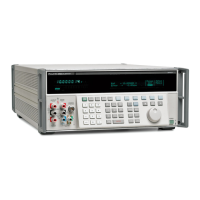Features
Front Panel Features 3
3-5
Table 3-1. Front Panel Features (continued)
External Sensing should be used in the dc voltage function when the UUT
draws enough current to produce a significant voltage drop in the cables,
and in the resistance function when the UUT has a four-wire ohms input and
the calibrator is set to 100 kΩ or less. External sensing can also be used in
conjunction with the two-wire compensation circuit to compensate for lead
resistance at the UUT terminals. Refer to "When to use External Sensing,"
"Four-Wire vs. Two-Wire Resistance Connections," and "Cable
Connections" in Chapter 4 for external sensing instructions.
E
x (External Guard)
Opens and closes an internal connection between V GUARD (voltage guard)
and OUTPUT LO. The calibrator powers up with the voltage guard internally
connected to OUTPUT LO and the EX GRD indicator off. Toggling
x on
disconnects OUTPUT LO from the voltage guard.
The V GUARD binding post provides an external connection point for the
voltage internal guard. For a UUT with floating inputs, the V GUARD should
be connected to LO internally. (
x is off.) For a UUT with a grounded input,
the GUARD may be externally connected to the grounded UUT input.
(x is on.) See Chapter 4 for instructions.
F
w (Wideband)
Toggles the Wideband AC Voltage Module (Option 5700A-03) and sets the
calibrator to standby. When enabled, the ac voltage output from 10 Hz to
30 MHz is available at the front-panel coaxial connector. Wideband is
disabled whenever W BND is toggled off or when another function (such as
current) is selected. Chapter 4 contains more information.
1 3
4
5
6
2
Figure 3-1. Front Panel Features

